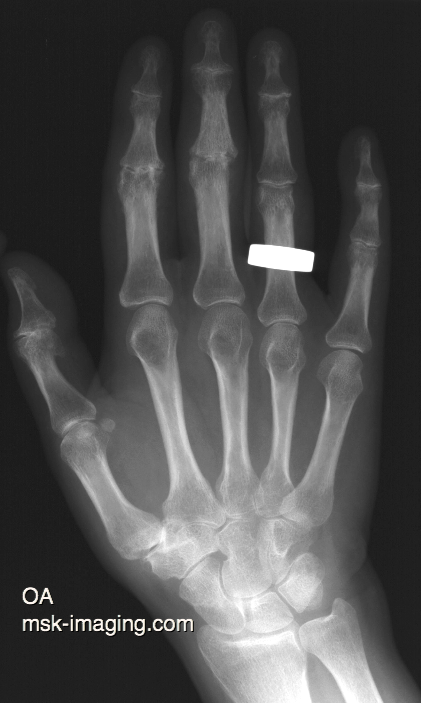

ARTHRITIS X RAY PATTERNS DIFFERENTIAL DIAGNOSIS
Plain films have traditionally been used in the assessment of small joint arthritis, but are becoming outdated.
Report should include comments on:
• peri-articular osteoporosis
• soft tissue swelling,
• increase in joint space in the early period and
• decrease in joint space later
• marginal erosions at later stages of the disease.
• Pattern / Distribution of involvement
• enthesopathy with new bone formation at
• ligament and tendon insertions
• fluffy periosteal thickening in the adjacent bones.
The first 6 are positive in RA, the last 3 more typical seronegative arthritis
PATTERN OF DISEASE
Involvement of the MCP and PIP joints is typical for RA
Involvement of the DIP joints is more characteristic of OA and seronegative arthritis.
The erosions of RA are poorly defined
Seen on the radial aspect of the MC heads and the bases of the proximal phalanges.
EROSIONS
Occur not only in rheumatoid arthritis but also in osteoarthritis (erosive osteoarthritis)
Erosions may also occur in seronegative arthritides particularly involving DIP joint.
Erosions and peri-articular bony irregularity quite common in OA.
Differentiation between osteoarthritis and seronegative (psoriatic) arthritis of the DIPJ can be difficult.
The erosions in psoriatic arthropathy resemble Mickey Mouse Ears
The erosions in OA involve the central part leading to seagull appearance.
Erosions also occur with gout.... Like RA these tend to be marginal and often lie away from the joint (juxtaarticular)
Gouty erosions tend to be more sharply defined
with an overhanging edge.
As joint involvement is relatively late, sparing of particularly the joint in gout is also a characteristic feature.
OTHER FEATURES
Soft tissue swelling and peri-articular osteoporosis can be difficult to detect
Peri-articular osteoporosis is most easily appreciated at the wrist.
Soft tissue swelling is best appreciated by comparison with other joints.
Soft tissue swelling in rheumatoid arthritis tends also to be symmetrical
Asymmetry is more common in patients with gouty arthritis.
When present, look for associated calcification which might mean a gouty tophus.
Soft tissue calcification in the skin and subcutaneous fat in patients with dermatomyositis and scleroderma.
Calcification in cartilage or menisci is a clue to a crystal deposition arthropathy such as calcium pyrophosphate deposition.
It should be appreciated that calcification in these structures is also a feature of increasing age.
THE PROBLEM WITH XRAYS
X Ray findings are all relatively late. .. But disease modifying therapy requires early diagnosis.
Also may only show monoarthritis when polyarthritis is present.
For these reasons, attention is now focussed on cross sectional imaging and MRI and ultrasound are both used.
There is considerable evidence that both of these detect synovitis and erosions at an earlier stage

